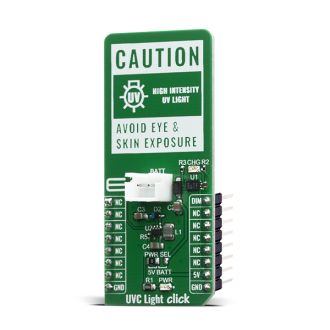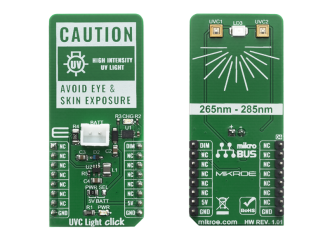
We strongly encourage users to use Package manager for sharing their code on Libstock website, because it boosts your efficiency and leaves the end user with no room for error. [more info]

Rating:
Author: MIKROE
Last Updated: 2020-06-19
Package Version: 1.0.0.0
mikroSDK Library: 1.0.0.0
Category: LED Drivers
Downloaded: 3093 times
Not followed.
License: MIT license
UVC Light Click is Click board with ultraviolet LEDs with 275nm wavelength. UVC radiation refers to wavelengths shorter than 280 nm. Because of the spectral sensitivity of DNA, only the UVC region demonstrates significant germicidal properties.
Do you want to subscribe in order to receive notifications regarding "UVC Light click" changes.
Do you want to unsubscribe in order to stop receiving notifications regarding "UVC Light click" changes.
Do you want to report abuse regarding "UVC Light click".


Library Description
The library contains basic PVM LED control functions.
Key functions:
uint32_t uvclight_pwmInit(uint16_t freq) - PWM init functionsvoid uvclight_pwmSetDuty(uint16_t duty) - PWM set duty cycleExamples description
The application is composed of three sections :
void application_task ( )
{
int32_t duty_cycle;
for ( duty_cycle = 0; duty_cycle < pwm_max_duty; duty_cycle+= pwm_degree )
{
uvclight_pwm_set_duty( duty_cycle );
Delay_ms( 10 );
}
Delay_ms( 500 );
for ( duty_cycle = pwm_max_duty; duty_cycle >= 0; duty_cycle-= pwm_degree )
{
uvclight_pwm_set_duty( duty_cycle );
Delay_ms( 10 );
}
Delay_ms( 500 );
}
Other mikroE Libraries used in the example:
Additional notes and informations
Depending on the development board you are using, you may need USB UART click, USB UART 2 click or RS232 click to connect to your PC, for development systems with no UART to USB interface available on the board. The terminal available in all MikroElektronika compilers, or any other terminal application of your choice, can be used to read the message.